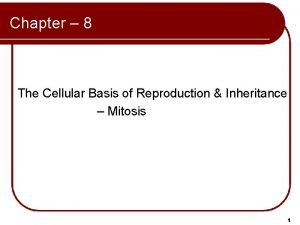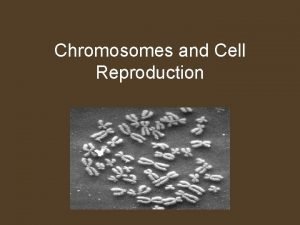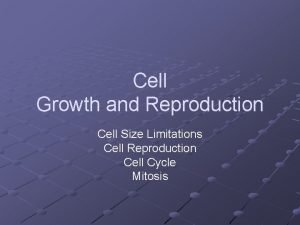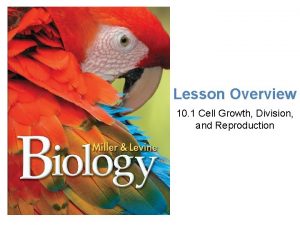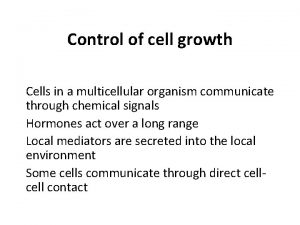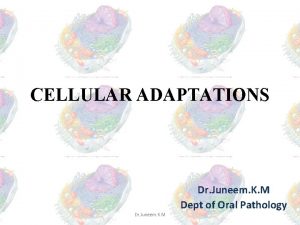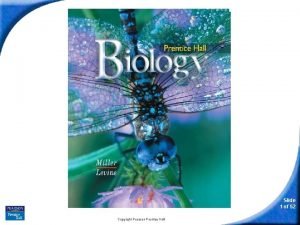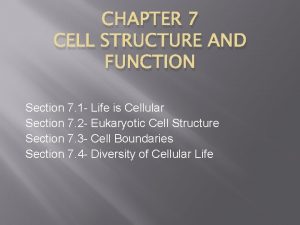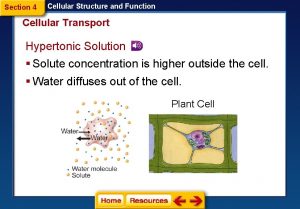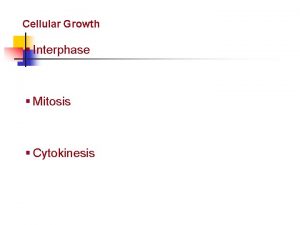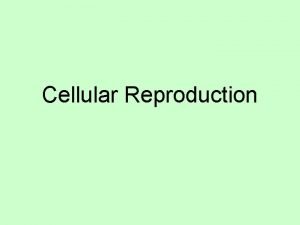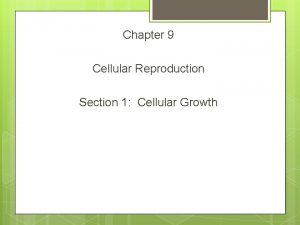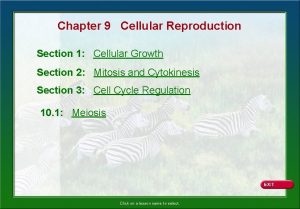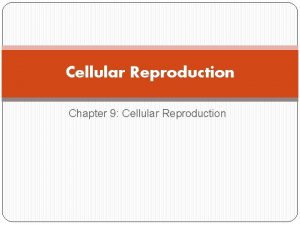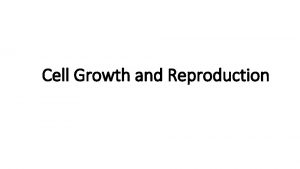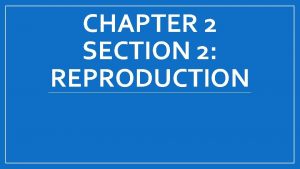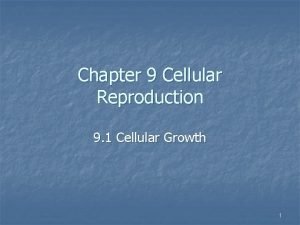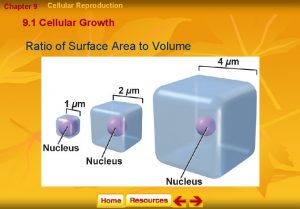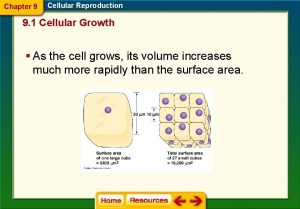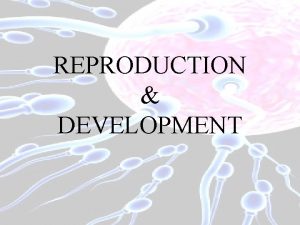Cellular Reproduction Section 1 Cellular Growth Section 2




























- Slides: 28

Cellular Reproduction Section 1: Cellular Growth Section 2: Mitosis and Cytokinesis Section 3: Cell Cycle Regulation Click on a lesson name to select.

Section 1 Cellular Reproduction Cellular Growth Ratio of Surface Area to Volume

Section 1 Cellular Reproduction Cellular Growth § As the cell grows, its volume increases much more rapidly than the surface area. § The cell might have difficulty supplying nutrients and expelling enough waste products.

Section 1 Cellular Reproduction Cellular Growth Transport of Substances § Substances move by diffusion or by motor proteins. § Diffusion over large distances is slow and inefficient. § Small cells maintain more efficient transport systems.

Section 1 Cellular Reproduction Cellular Growth Cellular Communications § The need for signaling proteins to move throughout the cell also limits cell size. § Cell size affects the ability of the cell to communicate instructions for cellular functions.

Section 2 Cellular Reproduction Cellular Growth The Cell Cycle § Cell division prevents the cell from becoming too large. § It also is the way the cell reproduces so that you grow and heal certain injuries. § Cells reproduce by a cycle of growing and dividing called the cell cycle.

Section 2 Cellular Reproduction Cellular Growth § Interphase is the stage during which the cell grows, carries out cellular functions, and replicates. §G 1 - cell growth §S - chromosomes are duplicated §G 2 - cell growth

Section 2 Cellular Reproduction Cellular Growth § Mitosis(M phase) is the stage of the cell cycle during which the cell’s nucleus and nuclear material divide. § Cytokinesis(C phase) is the method by which a cell’s cytoplasm divides, creating a new cell.

Section 2

Section 1 Cellular Reproduction Cellular Growth The Stages of Interphase § The first stage of interphase, G 1 § The cell is growing, carrying out normal cell functions, and preparing to replicate DNA.

Section 1 Cellular Reproduction Cellular Growth The Second Stage of Interphase, S § S stands for synthesis of DNA § The cell copies its DNA in preparation for cell division.

Section 1 Cellular Reproduction Cellular Growth The Third Stage of Interphase, G 2 § The cell continues to grow and prepares for the division of its nucleus.

Section 2 Cellular Reproduction Mitosis and Cytokinesis The Stages of Mitosis § Prophase § The cell’s chromatin tightens and coils forming discrete chromosomes. § Sister chromatids are attached at the centromere. § Spindle fibers form in the cytoplasm.

Section 2 Cellular Reproduction Mitosis and Cytokinesis § The nuclear envelope and nucleolus seems to disappear. § Spindle fibers attach to the sister chromatids at centromere. § Whole structure including aster, centrioles, and spindle fibers is called the spindle apparatus

Section 2 Cellular Reproduction Mitosis and Cytokinesis Metaphase § Sister chromatids are pulled along the spindle apparatus toward the center of the cell § They line up in the middle of the cell (equator/metaphase plate).

Section 2 Cellular Reproduction Mitosis and Cytokinesis Anaphase § The microtubules of the spindle apparatus begin to shorten. § This causes sister chromatids separate into two identical chromosomes. § The chromosomes move toward the poles of the cell.

Section 2 Cellular Reproduction Mitosis and Cytokinesis Telophase § The chromosomes arrive at the poles and begin to relax/decondense. § Two new nuclear membranes begin to form and the nucleoli reappear. § The spindle apparatus disassembles.

Section 2 Cellular Reproduction Mitosis and Cytokinesis § Process that divides the cytoplasm and final step in cell division § In animal cells, microfilaments constrict, or pinch, the cytoplasm. This area of constriction is called the cleavage furrow § In plant cells, a new structure forms b/w the two daughter nuclei, called a cell plate. (formation of cell wall)

Section 2 http: //faculty. baruch. cuny. edu/jwahlert/bio 1003/mit osis. html

Section 2 Prokaryotes • Divide by binary fission – DNA duplicates and attach to P. M. – P. M. grows and pulls DNA molecules apart – Fission is completed w/formation of two new prokaryotic cells

Section 3 Cellular Reproduction Cell Cycle Regulation Normal Cell Cycle § Different cyclin/CDK combinations signal other activities, including DNA replication, protein synthesis, and nuclear division throughout the cell cycle.

Section 3 Cellular Reproduction Cell Cycle Regulation Quality Control Checkpoints § The cell cycle has built-in checkpoints that monitor the cycle and can stop it if something goes wrong. § Spindle checkpoints also have been identified in mitosis.

Section 3 Cellular Reproduction Cell Cycle Regulation Abnormal Cell Cycle: Cancer § Cancer is the uncontrolled growth and division of cells. § Cancer cells can kill an organism by crowding out normal cells, resulting in the loss of tissue function.

Section 3 Cellular Reproduction Cell Cycle Regulation Causes of Cancer § The changes that occur in the regulation of cell growth and division of cancer cells are due to mutations. § Various environmental factors can affect the occurrence of cancer cells.

Section 3 Cellular Reproduction Cell Cycle Regulation Apoptosis § Programmed cell death § Cells going through apoptosis actually shrink and shrivel in a controlled process.

Section 3 Cellular Reproduction Cell Cycle Regulation Stem Cells § Unspecialized cells that can develop into specialized cells when under the right conditions

Section 3 Cellular Reproduction Cell Cycle Regulation Embryonic Stem Cells § After fertilization, the resulting mass of cells divides repeatedly until there about 100– 150 cells. These cells have not become specialized.

Section 3 Cellular Reproduction Cell Cycle Regulation Adult Stem Cells § Found in various tissues in the body and might be used to maintain and repair the same kind of tissue § Less controversial because the adult stem cells can be obtained with the consent of their donor Cellular Reproduction
 Chapter 9 cellular reproduction
Chapter 9 cellular reproduction Chapter 9 section 1 cellular growth
Chapter 9 section 1 cellular growth Binary fission in bacteria
Binary fission in bacteria Hare lynx
Hare lynx Asexual and sexual reproduction venn diagram
Asexual and sexual reproduction venn diagram The cellular basis of reproduction and inheritance
The cellular basis of reproduction and inheritance Chapter 9 cellular reproduction
Chapter 9 cellular reproduction Nondisjunction in meiosis
Nondisjunction in meiosis Growth and reproduction
Growth and reproduction Growth and reproduction
Growth and reproduction Cell growth division and reproduction
Cell growth division and reproduction Cellular adaptation of growth and differentiation
Cellular adaptation of growth and differentiation Cellular adaptation of growth and differentiation
Cellular adaptation of growth and differentiation Plant growth definition
Plant growth definition Monocots vs eudicots
Monocots vs eudicots Growthchain
Growthchain Primary growth and secondary growth in plants
Primary growth and secondary growth in plants Chapter 35 plant structure growth and development
Chapter 35 plant structure growth and development Geometric vs exponential growth
Geometric vs exponential growth Neoclassical growth theory vs. endogenous growth theory
Neoclassical growth theory vs. endogenous growth theory Organic vs inorganic growth
Organic vs inorganic growth Section 1 meiosis
Section 1 meiosis Chapter 10 section 3 gene linkage and polyploidy
Chapter 10 section 3 gene linkage and polyploidy Section 24-1 reproduction with cones and flowers
Section 24-1 reproduction with cones and flowers Chapter 8 section 3: cellular respiration
Chapter 8 section 3: cellular respiration Chapter 8 section 2: photosynthesis
Chapter 8 section 2: photosynthesis Section 7-1 life is cellular
Section 7-1 life is cellular Section 4 cellular transport answer key
Section 4 cellular transport answer key Chapter 7-1 life is cellular answer key
Chapter 7-1 life is cellular answer key





